SEO
What You Need To Know

To stay relevant, brands must continue to engage their customers through ads, contests, and other marketing strategies.
But what is a Facebook competition? How does it work? And why should I care?
Competitions are a great way to get noticed and build brand awareness. They are excellent for getting more likes on your page and in your group or boosting traffic to your site. They also provide a fun opportunity to interact with your audience.
Competitions on Facebook can involve posting a question or challenge, then promoting it to engage your followers.
Rewards can include cash prizes, gifts, or even admission to exclusive events.
But before jumping into a competition, there are some things you should consider. To ensure your competition is a success, check out these helpful tips.
1. What Are Facebook’s Official Rules?
Like most aspects of Facebook, there are official rules, including rules for all competitions.
However, the rules tend to change as new policies arise, so it’s important to check them before starting a competition. The current ones include:
Setting Up Your Own Restrictions
When you create a competition, the owner of the Facebook Page or Group’s job is to ensure they run properly and lawfully.
This means you have to set up terms and eligibility requirements which would include the age range for who can participate and the region for the competition.
So, for example, a brand can set guidelines that only people 18 plus in the U.S. can participate in the competition.
It also means that there need to be clear standards of how the competition will be run. Such as how and when the participants will participate and receive rewards.
Transparency is paramount. It will ensure everyone knows how the competition will operate and won’t get your brand in any sticky situations with Facebook or the law.
Create A Statement About Facebook
You will also need to mention in a post or release that Facebook is not involved in the competition in any way. And that the brand itself is in charge and responsible for the competition.
The participants also need to agree to these terms. So, it’s your job to get the participants to consent to these terms before participating.
Restrictions To Where You Can Post About The Campaign
Only official Facebook Pages, Groups, or Events can be used as platforms to promote a competition.
A brand can’t encourage its team or other participants to promote, tag, or share the competition on their personal Timelines.
People can find this as a spammy way to promote a competition anyway, so this shouldn’t impact promoting your competition.
Understanding Who’s Involved
Unfortunately, you are on your own and in charge of running a campaign on Facebook. So, Facebook can’t get involved if issues arise; it’s your job to manage any potential problems.
2. What Objectives Do You Want To Achieve?
Now that you know the rules, it’s time to set your goals for the competition.
There are numerous objectives you can select for a Facebook competition.
Some of them include:
- Increasing likes or followers.
- Getting traffic from other pages.
- Building engagement
- Promoting a product or service.
If you want to increase the number of likes you receive for posts and use a competition to help with this, then you need to post regularly and interact with users.
To build engagement, you should ask questions to your participants and answer any responses they give.
Additionally, if you want to promote a product or service, you should use promotion tools like Facebook ads.
Generally, the main objectives of any Facebook competition are to increase engagement and gain followers.
If you want to achieve higher engagement rates, you need to create a competition where participants feel like they have something to gain.
This could mean giving away prizes to select participants after encouraging them to participate on your social media pages or directing them back to your website to sign up for your email subscription.
This helps you get more active leads while also generating engagement.
Tracking Your Competition
As you would set goals for other social media campaigns, selecting specific and measurable objectives is paramount. This way, you can track the success of the campaign.
Putting together a couple of key performance indicators (KPIs) can help inform your promotional strategy for your Facebook competition.
It’s also incredibly important to set a schedule to monitor Facebook promotion analytics regularly.
Promote Your Competition
For your competition to gain traction, you need to leverage your marketing efforts.
Whether your competition is run solely on Facebook or you’re using it across multiple platforms, it’s crucial to hit all areas where your customers follow you.
Either direct them back to Facebook to participate or be clear about how and where they can enter the competition on other platforms, such as your website.
Also, depending on your brand goals for the competition, it may be worth boosting it as a paid Facebook post.
You can also customize your campaign by creating unique hashtags. This will help participants associate a post with your competition to remind them to enter if they haven’t done so already or reignite their excitement about potential prizes.
In addition, remember to establish a set schedule for when and how you will post about your competition throughout its duration.
Do You Need An App For Your Competition?
Using a third-party app to run your competition removes a lot of the headache associated with running a promotion but also has some drawbacks.
For example, they may not offer any additional functionality beyond what your team can manage.
Also, if you plan on promoting through Facebook ads, you’ll need to pay separately for each campaign (which could get expensive).
And finally, these apps aren’t usually designed to work on mobile devices, so you won’t be able to access them easily from a smartphone or tablet.
3. Who Is The Audience You Want To Enter?
With your objectives and rules established, it’s time to decide who you want to get involved in your competition. It’s essential to tailor your competition to your target audience.
What do you think your target audience wants? Do you have a new product or product line coming out soon? Then maybe you can gift a couple of participants some of these products.
Or perhaps there is a product that is generally sold out. Then a couple of lucky winners can receive this elusive good.
You could also create a limited edition product specifically for the competition. This way, more people will get excited to participate, so they don’t miss out on this one-time offer.
Figuring out what your audience wants most can help improve the success of your competition. Choose a prize that appeals to your ideal customers. You want your participants to be excited when they finally get their gift.
Finally, think carefully about how you’re reaching your target audience.
Will they respond positively to how you plan to promote your competition? Are you offering enough prizes for the type of following you have on Facebook or across social media?
4. What Type Of Competition Do You Choose?
A Facebook competition requires a lot of planning. Before starting any Facebook competition, you need to decide how much effort and money you want to put into the competition.
Such as how much money you want to spend on Facebook ads and other promotional activities, as well as what prizes you want to give away and how many prizes you’re willing to offer. Then it’ll be easier to select what type of competition would work best.
Three traditional competitions include giveaways, sweepstakes, and contests. Each has different rules.
If you plan to run a giveaway, you should consider limiting how many products you give away. Usually, with a giveaway, a set number of the people who participate first receive a prize.
A sweepstake is more of a lottery where you would select a certain number of participants from the pull of participants that enter the competition over a period of time.
And a contest would have more specific criteria that the participants need to follow, and then the participant(s) who best follow the criteria would win. Such as a picture contest.
How Long Will The Competition Run?
If you want to run a competition on Facebook, then you should know how long the competition will last. The typical duration is one month.
However, some competitions may be open longer if you have the budget and time or certain long-term goals for that competition.
Some competitions end when they reach a certain number of entries, while others continue until a specific date.
5. How Will You Follow Up With Participants?
It’s crucial to communicate how you will follow up with your participants to let them know who won the competition.
This way, you won’t create any unnecessary upsetness or miscommunicate about when the prizes will go out. You don’t want to waste all your hard work by ending the competition on a sour note.
Here are some tips on how you can follow up with participants after the competition ends:
- Announce the end of the competition and thank everyone for participating.
- Make a note of the winners’ names and send them a message with the information about how and when they will receive the prize.
- Finally, don’t forget to check periodically to see what new messages or comments they leave.
Takeaways
Facebook competitions are a fun way to promote your company, brand, product, service, or cause.
Also, they are a great way to build a community around your brand and get feedback from followers.
They’re free to enter, easy to set up, and fun to watch. So, if you want to build a community around your product or service, try creating a Facebook competition.
More Resources:
Featured Image: Dean Drobot/Shutterstock
SEO
Measuring Content Impact Across The Customer Journey
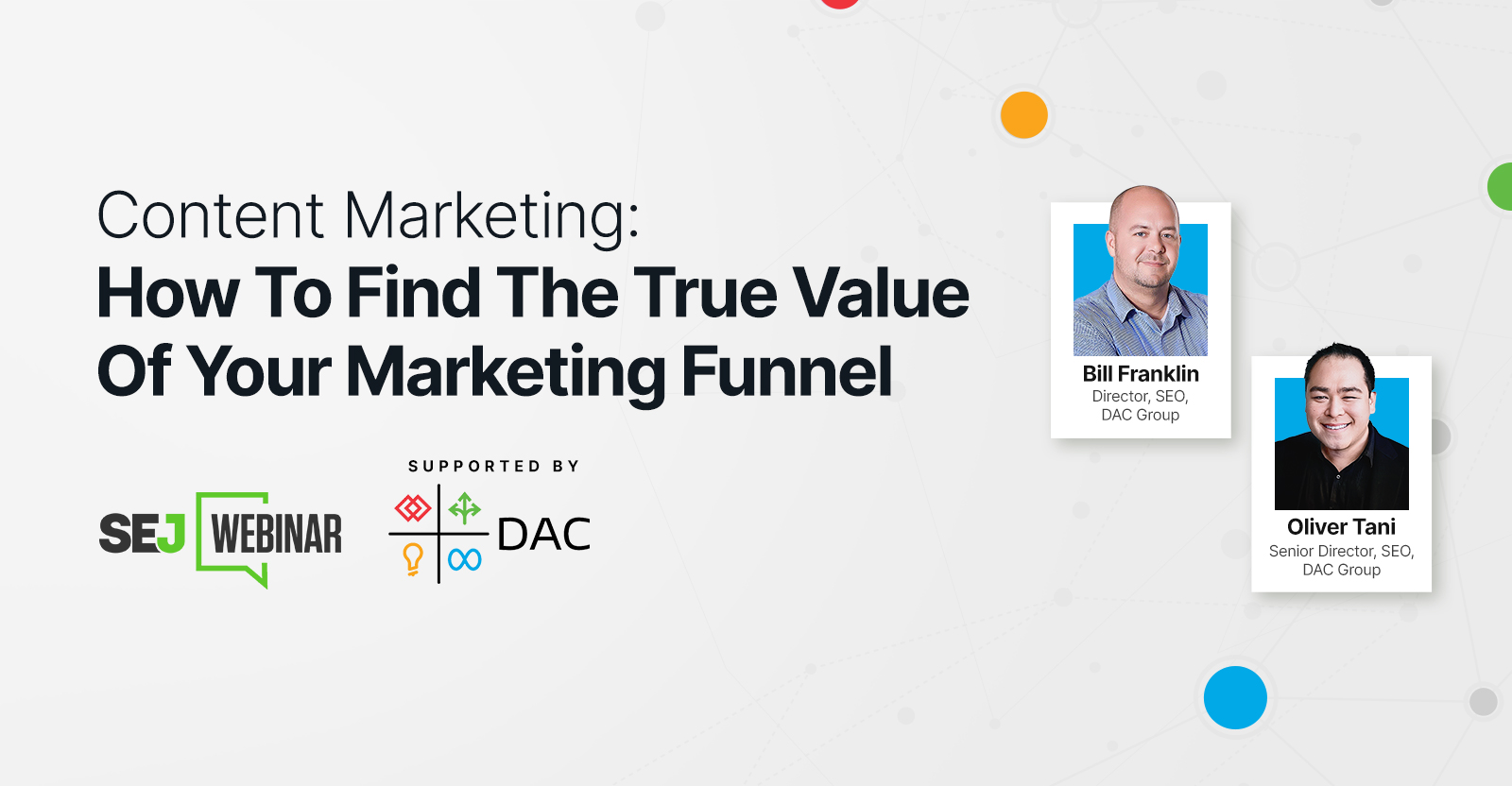
Understanding the impact of your content at every touchpoint of the customer journey is essential – but that’s easier said than done. From attracting potential leads to nurturing them into loyal customers, there are many touchpoints to look into.
So how do you identify and take advantage of these opportunities for growth?
Watch this on-demand webinar and learn a comprehensive approach for measuring the value of your content initiatives, so you can optimize resource allocation for maximum impact.
You’ll learn:
- Fresh methods for measuring your content’s impact.
- Fascinating insights using first-touch attribution, and how it differs from the usual last-touch perspective.
- Ways to persuade decision-makers to invest in more content by showcasing its value convincingly.
With Bill Franklin and Oliver Tani of DAC Group, we unravel the nuances of attribution modeling, emphasizing the significance of layering first-touch and last-touch attribution within your measurement strategy.
Check out these insights to help you craft compelling content tailored to each stage, using an approach rooted in first-hand experience to ensure your content resonates.
Whether you’re a seasoned marketer or new to content measurement, this webinar promises valuable insights and actionable tactics to elevate your SEO game and optimize your content initiatives for success.
View the slides below or check out the full webinar for all the details.
SEO
How to Find and Use Competitor Keywords

Competitor keywords are the keywords your rivals rank for in Google’s search results. They may rank organically or pay for Google Ads to rank in the paid results.
Knowing your competitors’ keywords is the easiest form of keyword research. If your competitors rank for or target particular keywords, it might be worth it for you to target them, too.
There is no way to see your competitors’ keywords without a tool like Ahrefs, which has a database of keywords and the sites that rank for them. As far as we know, Ahrefs has the biggest database of these keywords.
How to find all the keywords your competitor ranks for
- Go to Ahrefs’ Site Explorer
- Enter your competitor’s domain
- Go to the Organic keywords report
The report is sorted by traffic to show you the keywords sending your competitor the most visits. For example, Mailchimp gets most of its organic traffic from the keyword “mailchimp.”


Since you’re unlikely to rank for your competitor’s brand, you might want to exclude branded keywords from the report. You can do this by adding a Keyword > Doesn’t contain filter. In this example, we’ll filter out keywords containing “mailchimp” or any potential misspellings:
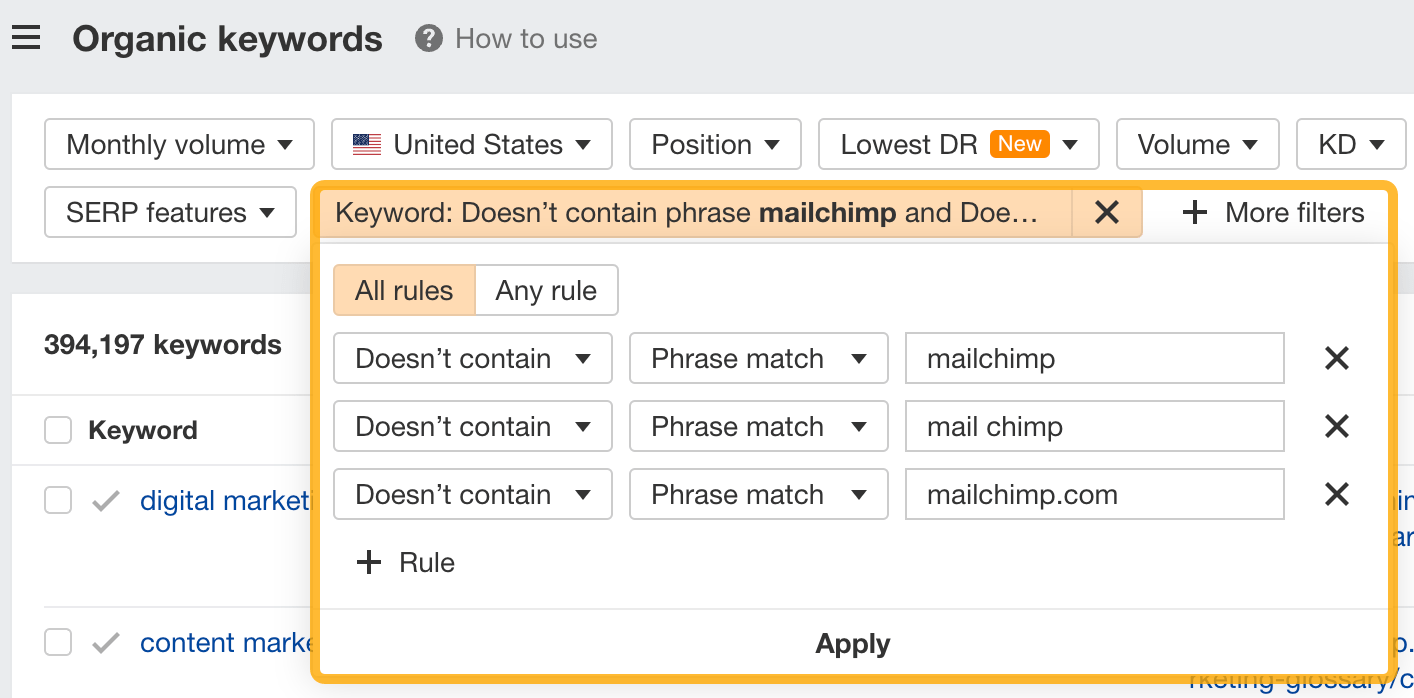

If you’re a new brand competing with one that’s established, you might also want to look for popular low-difficulty keywords. You can do this by setting the Volume filter to a minimum of 500 and the KD filter to a maximum of 10.


How to find keywords your competitor ranks for, but you don’t
- Go to Competitive Analysis
- Enter your domain in the This target doesn’t rank for section
- Enter your competitor’s domain in the But these competitors do section


Hit “Show keyword opportunities,” and you’ll see all the keywords your competitor ranks for, but you don’t.


You can also add a Volume and KD filter to find popular, low-difficulty keywords in this report.


How to find keywords multiple competitors rank for, but you don’t
- Go to Competitive Analysis
- Enter your domain in the This target doesn’t rank for section
- Enter the domains of multiple competitors in the But these competitors do section
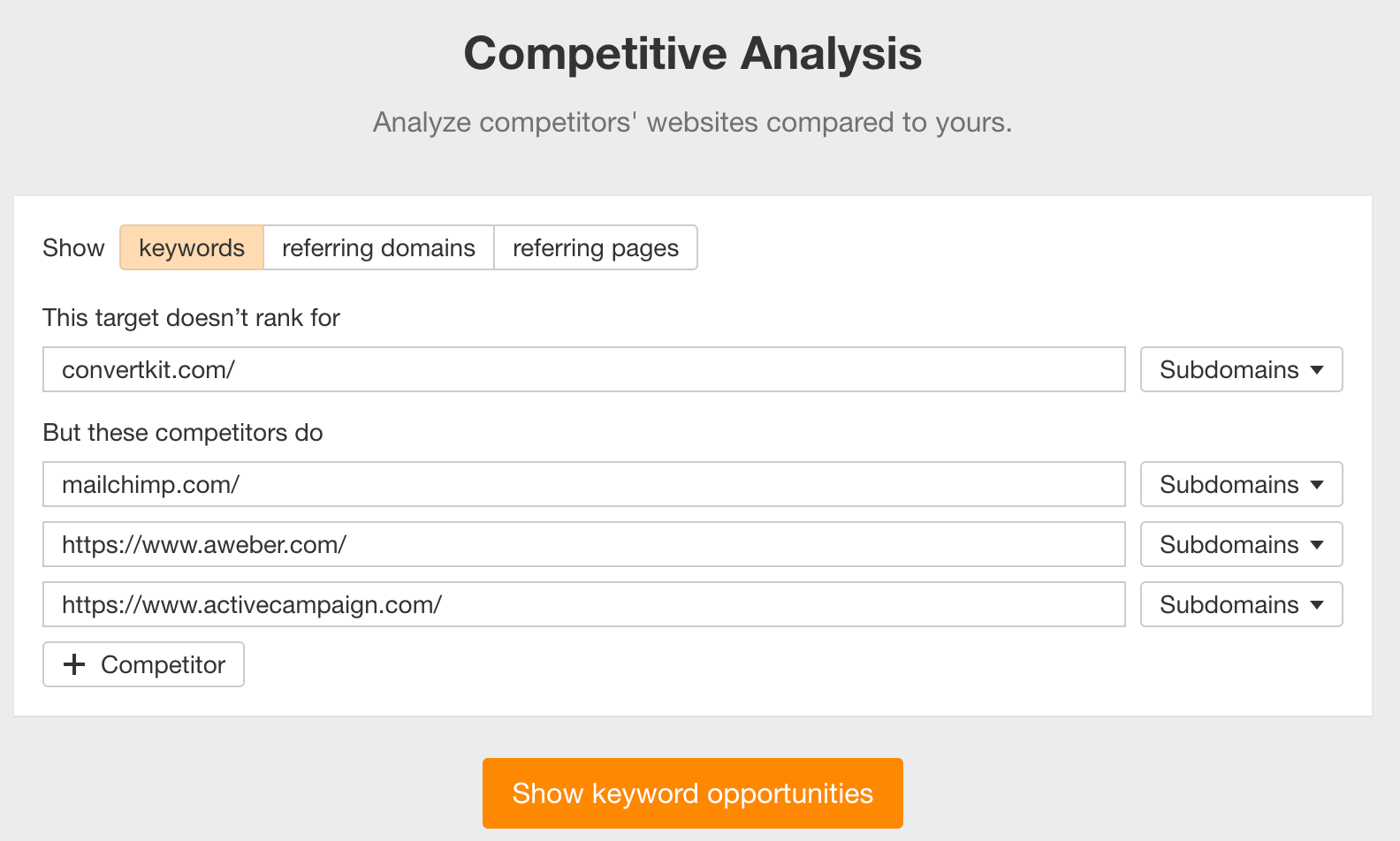

You’ll see all the keywords that at least one of these competitors ranks for, but you don’t.


You can also narrow the list down to keywords that all competitors rank for. Click on the Competitors’ positions filter and choose All 3 competitors:


- Go to Ahrefs’ Site Explorer
- Enter your competitor’s domain
- Go to the Paid keywords report
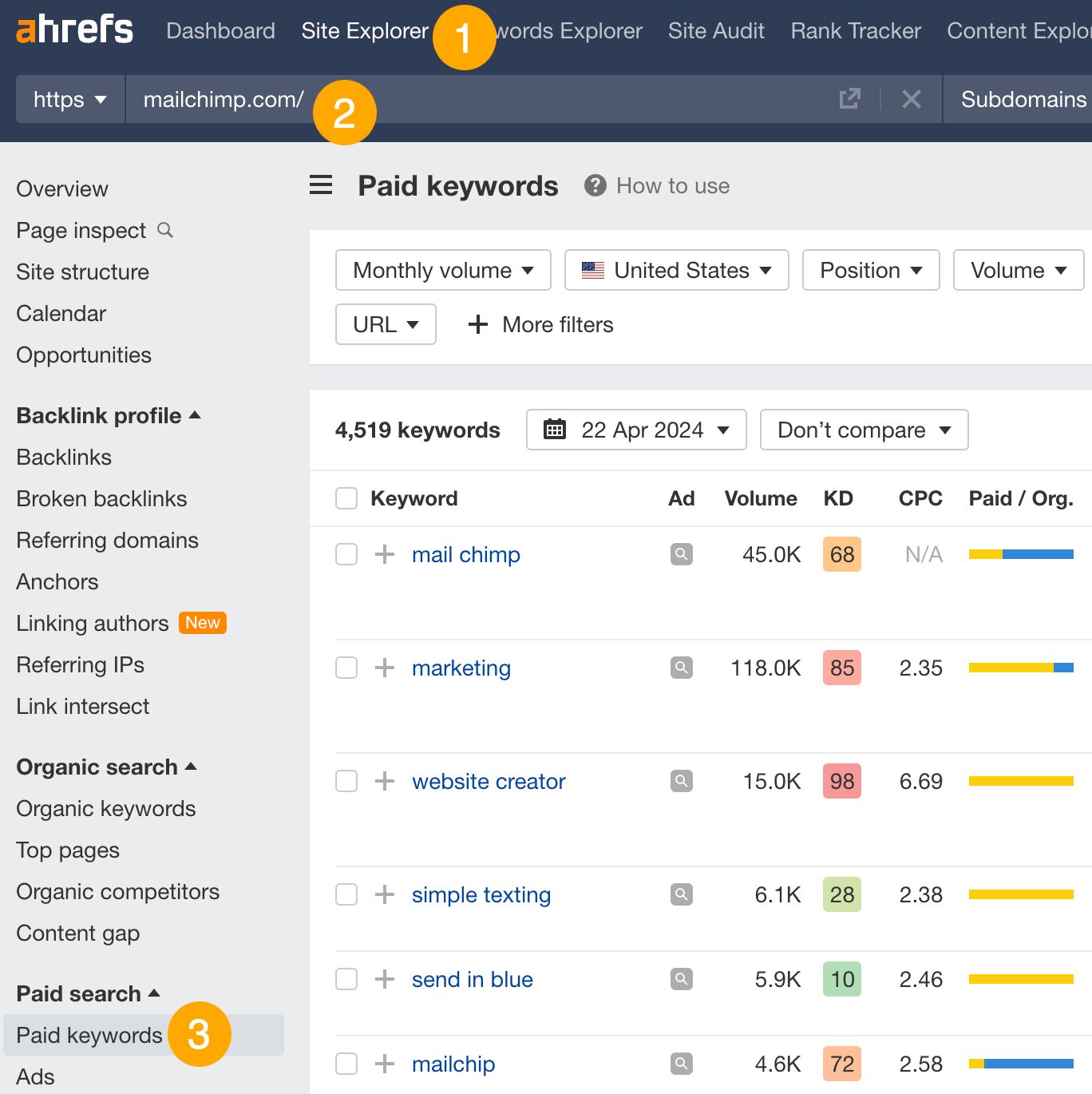

This report shows you the keywords your competitors are targeting via Google Ads.
Since your competitor is paying for traffic from these keywords, it may indicate that they’re profitable for them—and could be for you, too.
You know what keywords your competitors are ranking for or bidding on. But what do you do with them? There are basically three options.
1. Create pages to target these keywords
You can only rank for keywords if you have content about them. So, the most straightforward thing you can do for competitors’ keywords you want to rank for is to create pages to target them.
However, before you do this, it’s worth clustering your competitor’s keywords by Parent Topic. This will group keywords that mean the same or similar things so you can target them all with one page.
Here’s how to do that:
- Export your competitor’s keywords, either from the Organic Keywords or Content Gap report
- Paste them into Keywords Explorer
- Click the “Clusters by Parent Topic” tab


For example, MailChimp ranks for keywords like “what is digital marketing” and “digital marketing definition.” These and many others get clustered under the Parent Topic of “digital marketing” because people searching for them are all looking for the same thing: a definition of digital marketing. You only need to create one page to potentially rank for all these keywords.
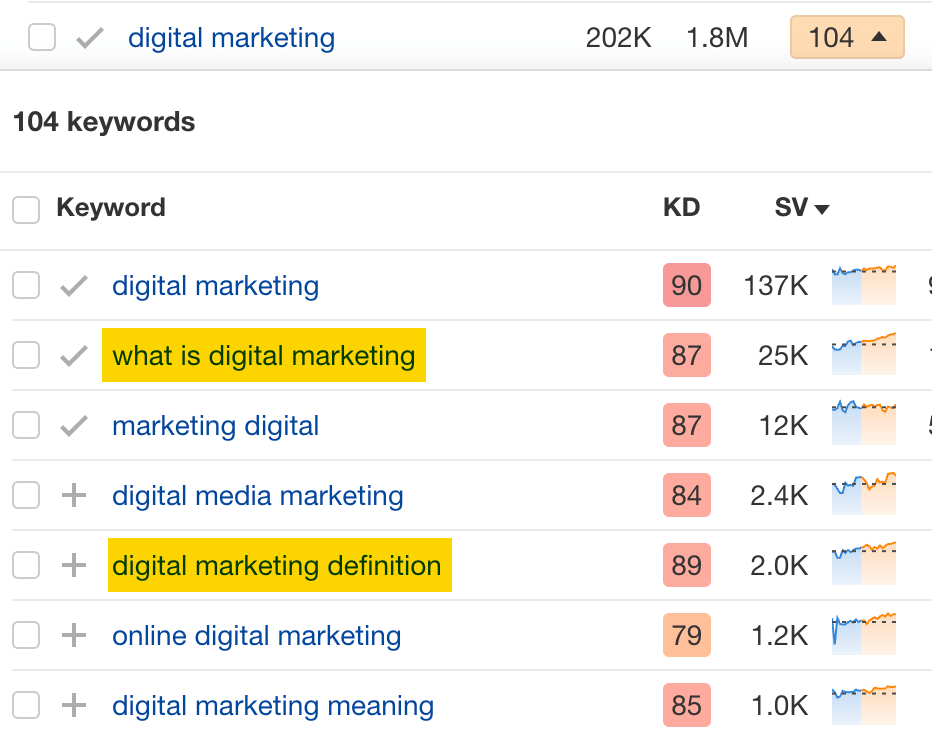

2. Optimize existing content by filling subtopics
You don’t always need to create new content to rank for competitors’ keywords. Sometimes, you can optimize the content you already have to rank for them.
How do you know which keywords you can do this for? Try this:
- Export your competitor’s keywords
- Paste them into Keywords Explorer
- Click the “Clusters by Parent Topic” tab
- Look for Parent Topics you already have content about
For example, if we analyze our competitor, we can see that seven keywords they rank for fall under the Parent Topic of “press release template.”


If we search our site, we see that we already have a page about this topic.


If we click the caret and check the keywords in the cluster, we see keywords like “press release example” and “press release format.”
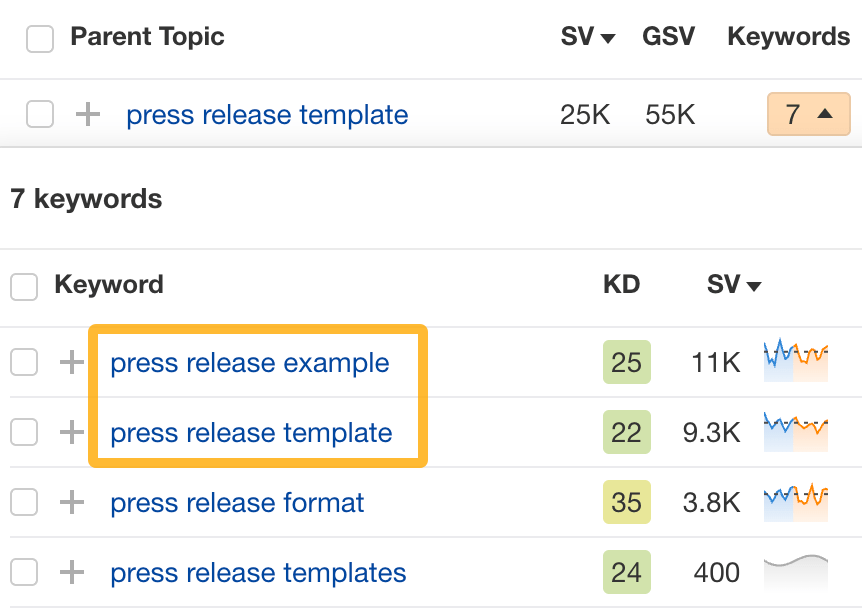

To rank for the keywords in the cluster, we can probably optimize the page we already have by adding sections about the subtopics of “press release examples” and “press release format.”
3. Target these keywords with Google Ads
Paid keywords are the simplest—look through the report and see if there are any relevant keywords you might want to target, too.
For example, Mailchimp is bidding for the keyword “how to create a newsletter.”


If you’re ConvertKit, you may also want to target this keyword since it’s relevant.
If you decide to target the same keyword via Google Ads, you can hover over the magnifying glass to see the ads your competitor is using.
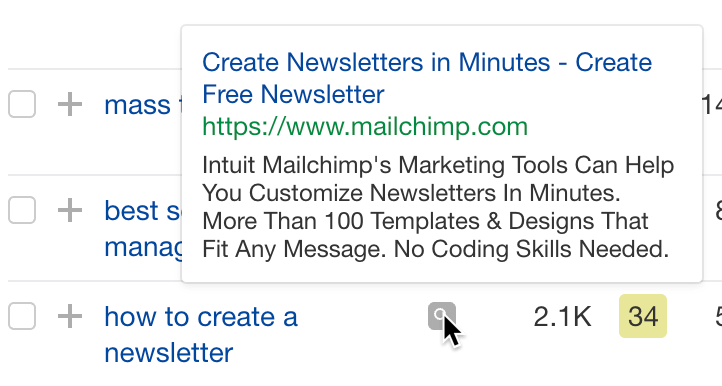

You can also see the landing page your competitor directs ad traffic to under the URL column.


Learn more
Check out more tutorials on how to do competitor keyword analysis:
SEO
Google Confirms Links Are Not That Important

Google’s Gary Illyes confirmed at a recent search marketing conference that Google needs very few links, adding to the growing body of evidence that publishers need to focus on other factors. Gary tweeted confirmation that he indeed say those words.
Background Of Links For Ranking
Links were discovered in the late 1990’s to be a good signal for search engines to use for validating how authoritative a website is and then Google discovered soon after that anchor text could be used to provide semantic signals about what a webpage was about.
One of the most important research papers was Authoritative Sources in a Hyperlinked Environment by Jon M. Kleinberg, published around 1998 (link to research paper at the end of the article). The main discovery of this research paper is that there is too many web pages and there was no objective way to filter search results for quality in order to rank web pages for a subjective idea of relevance.
The author of the research paper discovered that links could be used as an objective filter for authoritativeness.
Kleinberg wrote:
“To provide effective search methods under these conditions, one needs a way to filter, from among a huge collection of relevant pages, a small set of the most “authoritative” or ‘definitive’ ones.”
This is the most influential research paper on links because it kick-started more research on ways to use links beyond as an authority metric but as a subjective metric for relevance.
Objective is something factual. Subjective is something that’s closer to an opinion. The founders of Google discovered how to use the subjective opinions of the Internet as a relevance metric for what to rank in the search results.
What Larry Page and Sergey Brin discovered and shared in their research paper (The Anatomy of a Large-Scale Hypertextual Web Search Engine – link at end of this article) was that it was possible to harness the power of anchor text to determine the subjective opinion of relevance from actual humans. It was essentially crowdsourcing the opinions of millions of website expressed through the link structure between each webpage.
What Did Gary Illyes Say About Links In 2024?
At a recent search conference in Bulgaria, Google’s Gary Illyes made a comment about how Google doesn’t really need that many links and how Google has made links less important.
Patrick Stox tweeted about what he heard at the search conference:
” ‘We need very few links to rank pages… Over the years we’ve made links less important.’ @methode #serpconf2024″
Google’s Gary Illyes tweeted a confirmation of that statement:
“I shouldn’t have said that… I definitely shouldn’t have said that”
Why Links Matter Less
The initial state of anchor text when Google first used links for ranking purposes was absolutely non-spammy, which is why it was so useful. Hyperlinks were primarily used as a way to send traffic from one website to another website.
But by 2004 or 2005 Google was using statistical analysis to detect manipulated links, then around 2004 “powered-by” links in website footers stopped passing anchor text value, and by 2006 links close to the words “advertising” stopped passing link value, links from directories stopped passing ranking value and by 2012 Google deployed a massive link algorithm called Penguin that destroyed the rankings of likely millions of websites, many of which were using guest posting.
The link signal eventually became so bad that Google decided in 2019 to selectively use nofollow links for ranking purposes. Google’s Gary Illyes confirmed that the change to nofollow was made because of the link signal.
Google Explicitly Confirms That Links Matter Less
In 2023 Google’s Gary Illyes shared at a PubCon Austin that links were not even in the top 3 of ranking factors. Then in March 2024, coinciding with the March 2024 Core Algorithm Update, Google updated their spam policies documentation to downplay the importance of links for ranking purposes.
The documentation previously said:
“Google uses links as an important factor in determining the relevancy of web pages.”
The update to the documentation that mentioned links was updated to remove the word important.
Links are not just listed as just another factor:
“Google uses links as a factor in determining the relevancy of web pages.”
At the beginning of April Google’s John Mueller advised that there are more useful SEO activities to engage on than links.
Mueller explained:
“There are more important things for websites nowadays, and over-focusing on links will often result in you wasting your time doing things that don’t make your website better overall”
Finally, Gary Illyes explicitly said that Google needs very few links to rank webpages and confirmed it.
I shouldn’t have said that… I definitely shouldn’t have said that
— Gary 鯨理/경리 Illyes (so official, trust me) (@methode) April 19, 2024
Why Google Doesn’t Need Links
The reason why Google doesn’t need many links is likely because of the extent of AI and natural language undertanding that Google uses in their algorithms. Google must be highly confident in its algorithm to be able to explicitly say that they don’t need it.
Way back when Google implemented the nofollow into the algorithm there were many link builders who sold comment spam links who continued to lie that comment spam still worked. As someone who started link building at the very beginning of modern SEO (I was the moderator of the link building forum at the #1 SEO forum of that time), I can say with confidence that links have stopped playing much of a role in rankings beginning several years ago, which is why I stopped about five or six years ago.
Read the research papers
Authoritative Sources in a Hyperlinked Environment – Jon M. Kleinberg (PDF)
The Anatomy of a Large-Scale Hypertextual Web Search Engine
Featured Image by Shutterstock/RYO Alexandre
-

 PPC4 days ago
PPC4 days ago19 Best SEO Tools in 2024 (For Every Use Case)
-

 MARKETING7 days ago
MARKETING7 days agoWill Google Buy HubSpot? | Content Marketing Institute
-
SEARCHENGINES7 days ago
Daily Search Forum Recap: April 16, 2024
-

 SEO7 days ago
SEO7 days agoGoogle Clarifies Vacation Rental Structured Data
-

 MARKETING6 days ago
MARKETING6 days agoStreamlining Processes for Increased Efficiency and Results
-
SEARCHENGINES6 days ago
Daily Search Forum Recap: April 17, 2024
-

 SEO6 days ago
SEO6 days agoAn In-Depth Guide And Best Practices For Mobile SEO
-

 PPC6 days ago
PPC6 days ago97 Marvelous May Content Ideas for Blog Posts, Videos, & More















You must be logged in to post a comment Login